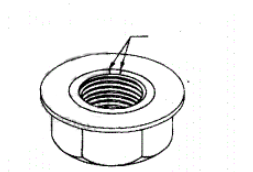Fastener nuts are common parts of connectors. For the use of fastener nuts, common surface defects are: cracks (quenching cracks, forging cracks and slag cracks, cracks in the locking part of the all-metal effective torque lock nut, nut-washer assembly crack on the gasket seat), shear burst, burst, crack, wrinkle, dent, cut and damage, etc.
1. Cracks
A crack is a clear (crystalline) fracture along the metal grain boundary or across the grain, and may contain inclusions of foreign elements. Cracks are often caused by excessive stress during forging or other forming processes or heat treatment of metals, and cracks may also exist in the raw materials. When the workpiece is heated again, the cracks are usually discolored due to the sharpness of the oxide scale.
(1) Quenching cracks

Causes for quenching cracks: In the heat treatment process, due to excessive thermal stress and strain, quenching cracks may occur. Quenching cracks are usually irregular and appear on the surface of the nut in irregular directions.
Note: Quenching cracks of any depth, length or any part are not allowed to exist.
(2) Forging cracks and slag cracks

Causes for forging cracks and slag inclusion cracks: Forging cracks may occur during cutting or forging processes, and are located on the top or bottom surface of the nut, or at the junction of the top surface (bottom surface) and the opposite plane. Slag inclusion cracks are caused by the inherent non-metallic slag inclusion of raw materials.
Note:
The cracks located on the nut bearing surface or the bottom and top surfaces shall meet the following requirements respectively:
a) There should be no more than two satin cracks running through the supporting surface, and the depth should not exceed 0.05D.
b) The crack extending into the screw hole should not exceed the first complete thread.
c) The crack depth on the first complete thread should not exceed 0.5H1.
D-the nominal diameter of the thread; H1-the actual thread height; H1=0.541P; P-the pitch.
(3) Cracks in the locking part of the all-metal effective torque lock nut
Causes: The cracks in the locking part of the all-metal effective torque lock nut may be produced during the process of cutting or forging or closing (flattening), and appear on the external or internal surface.

Note:
The cracks generated by forging and located in the locking part should be able to meet the mechanical and working performance requirements of the nut, and should also meet:
a. There should be no more than two cracks running through the top circumference, and the depth should not exceed 0.05D.
b. The crack extending into the screw hole should not exceed the first complete thread.
c. The crack depth on the first complete thread should not exceed 0.5H1.
Cracks in the locking part caused by the closing (flattening) should not be allowed.
D-the nominal diameter of the thread; H1-the actual thread height; H1=0.541P; P-the pitch.
(4) Cracks in the washer seat of the nut-washer assembly

The crack of the washer seat is the crack of the metal edge or the convex part in the process of fixing the washer on the nut.
Causes for cracks in the gasket seat of the nut-washer assembly: In the process of assembling the gasket, when pressure is applied to the edge or raised part, the gasket seat crack may occur.
Note: The crack of the gasket seat should be controlled within the edge or convex part after turning over the riveting, and the gasket should be able to rotate freely without falling off.
2. Shear burst

Shear burst is the cracking of the metal surface.
Causes for shear burst: Shear burst may occur during the forging process, such as on the outer surface of the nut or on the periphery of the flange face nut. Usually, the shear burst and the nut axis line are about 45°.
Note: The shear burst on the opposite side of the nut should not extend to the bearing surface of the hexagonal nut, or the top circumference of the flange face nut. The shear burst on the diagonal should not reduce the diagonal width below the specified minimum size. The width of the shear burst at the junction of the top or bottom of the nut and the opposite plane shall not be greater than (0.25+0.02 s) mm.
The shear burst on the flange surface of the flange nut should not extend to the minimum size of the diameter of the bearing surface, and its width should not exceed 0.08dc.
s-width across opposite sides; dc-flange diameter